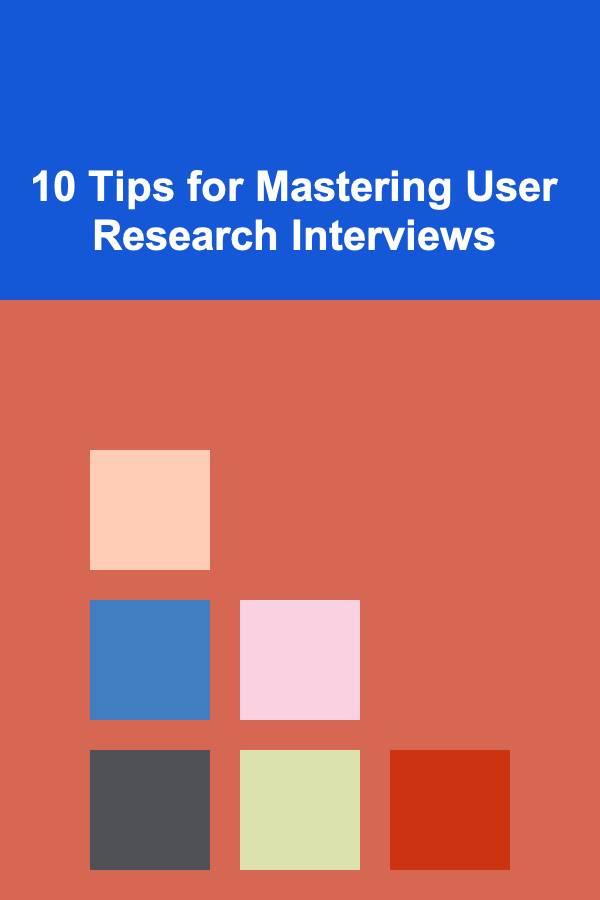
10 Tips for Mastering User Research Interviews
ebook include PDF & Audio bundle (Micro Guide)
$12.99$9.99
Limited Time Offer! Order within the next:

User research interviews are an essential part of understanding user behavior, motivations, pain points, and needs. Conducting successful user interviews is a skill that can significantly impact the quality of a product and the user experience. Through interviews, designers, researchers, and product managers gain insights that guide decision-making, improve usability, and lead to better outcomes.
Mastering user research interviews requires preparation, empathy, and adaptability. This article outlines 10 tips that will help you conduct effective and insightful user research interviews, making the process smoother and the findings more valuable.
Define Clear Research Goals
Before conducting any interview, it's important to have a well-defined purpose. What do you want to achieve with the interview? Clear research goals will guide your questions and help you stay focused on the right aspects of the user's experience.
- Identify your objectives: Are you trying to understand how users interact with a product? Are you investigating usability issues or exploring new feature ideas?
- Set clear questions: Based on your goals, craft specific questions that will uncover the insights you need. This might include exploring the user's pain points, understanding their decision-making process, or gaining feedback on specific features.
Having a defined set of research goals ensures you stay on track, and it helps participants feel more comfortable knowing why they are being interviewed.
Prepare Thoughtful, Open-Ended Questions
The questions you ask in a user research interview should be open-ended and designed to encourage thoughtful responses. Open-ended questions avoid yes/no answers, prompting users to reflect on their experiences, challenges, and thoughts.
- Avoid leading questions: Leading questions, such as "You must have liked this feature, right?" can bias the participant's response. Instead, ask neutral questions that encourage honest feedback. For example, "Can you tell me about your experience using this feature?"
- Use "Tell me about..." or "How did you feel about...": These question starters encourage participants to elaborate on their answers, providing more in-depth insights.
Open-ended questions make the conversation more natural, allowing you to dig deeper into the user's true thoughts and feelings.
Create a Comfortable Environment
The environment in which the interview takes place has a significant impact on the quality of the data you collect. A comfortable, non-judgmental setting helps users feel at ease, which in turn encourages more honest and detailed responses.
- Build rapport: Start the conversation with light, casual talk to make the participant comfortable. This will help them feel like they can be open and honest.
- Be non-judgmental: Users should feel safe sharing both positive and negative feedback without fear of judgment. Reassure them that their opinions are valued, regardless of whether they are critical or complimentary.
A relaxed environment helps participants open up, providing richer insights during the interview.
Listen Actively and Stay Engaged
Active listening is critical in user research interviews. It not only shows respect for the participant's views but also helps you gather deeper insights. Engaging actively with the interviewee allows you to follow up on their responses, explore topics further, and uncover hidden motivations.
- Paraphrase and summarize: After the participant shares something significant, paraphrase or summarize their words to ensure you understand them correctly. For instance, "So, what I'm hearing is that you find it difficult to navigate the settings section. Is that right?"
- Use affirmations: Show interest in the participant's responses with affirmations like "That's interesting!" or "Tell me more about that." This encourages the user to continue sharing.
Active listening builds a trusting connection, making participants feel heard and increasing the quality of the insights you gather.
Avoid Interrupting
While it's tempting to jump in with your own thoughts or follow-up questions as soon as a participant finishes talking, interrupting can disrupt the flow of the conversation and discourage participants from sharing freely.
- Let the user finish speaking: Give the participant time to express themselves fully before you ask another question or interject.
- Pause before responding: After the participant finishes, take a moment to consider their response. This ensures you ask thoughtful follow-up questions and provides space for users to continue talking if they have more to say.
Allowing participants the space to fully articulate their thoughts leads to richer, more nuanced insights.
Adapt Your Approach Based on the Participant
Every user is different, and the way they engage in an interview can vary. Some users are more introspective and detailed in their responses, while others might be more concise or hesitant to share. It's important to adapt your approach based on the participant's communication style.
- Tailor your questions: If a user is more reserved, use gentle prompts to encourage deeper responses. If a user is talkative, guide the conversation back to key topics without interrupting their flow.
- Observe body language: If conducting in-person or video interviews, pay attention to non-verbal cues. Body language can provide additional insights into how users feel about certain aspects of the product or service.
By adapting your approach to each participant, you can extract more relevant and valuable insights from the interview.
Don't Focus Too Much on the Product
While you're researching users' experiences with your product, it's essential to avoid tunnel vision. Don't make the interview solely about the product itself. Instead, explore the user's broader context to understand their needs and behaviors more holistically.
- Understand their goals: Ask about the user's goals, tasks, and challenges outside of your product. This can help you uncover the underlying problems that your product is trying to solve.
- Explore alternative solutions: Ask users what they do when they encounter the problems your product addresses. This will help you understand how your product fits into the bigger picture and identify any gaps in your solution.
By understanding users' broader experiences, you gain a deeper understanding of how your product serves (or doesn't serve) their needs.
Allow for Silence
Silence during a user interview can feel uncomfortable, but it's an important tool for gathering insights. After asking a question, resist the urge to fill the silence immediately. Instead, give the participant time to process the question and think before responding.
- Use silence strategically: If a participant finishes answering, allow a few moments of silence before moving on to the next question. Often, this gives the user space to offer more thoughts or reflect further on the topic.
- Encourage deep thinking: Silence allows participants to think about their responses in a more meaningful way. This often results in richer insights and more thoughtful feedback.
Giving participants space to think before answering results in more reflective and detailed responses.
Follow Up with Probing Questions
Sometimes, users will provide general answers that don't give you the detailed insights you need. In these cases, probing questions are essential to dig deeper into the user's experiences and feelings.
- Probe for examples: Ask participants to provide examples or specific situations related to their feedback. For instance, "Can you tell me about a time when you faced this issue?" or "How did you feel when that happened?"
- Clarify vague answers: If a participant gives a vague or unclear response, follow up with questions like, "What do you mean by that?" or "Can you explain that in more detail?"
Probing questions allow you to gain more detailed and actionable insights from your participants.
Document and Analyze Your Findings
The final step in conducting effective user research interviews is to document and analyze the insights you gather. Accurate documentation helps ensure that no valuable information is lost, while analysis helps turn raw data into actionable findings.
- Take thorough notes: If possible, record the interview (with the participant's permission) to ensure you don't miss anything. Take notes on key points, quotes, and emotions expressed during the conversation.
- Identify patterns: Once you've conducted several interviews, analyze the data to identify recurring themes, pain points, and patterns. This will help you draw meaningful conclusions and guide your design or product development process.
Effective documentation and analysis ensure that the insights you've gained from the interviews are actionable and valuable.
Conclusion
Mastering user research interviews requires preparation, active listening, adaptability, and an understanding of the broader context in which users operate. By following these 10 tips, you can improve the quality of your user interviews, gain deeper insights, and create better products that meet users' needs. A successful user interview is not just about asking the right questions but also about creating an environment that encourages open, honest, and thoughtful conversation. With these techniques in mind, you'll be well on your way to conducting interviews that deliver actionable insights and drive product success.
Reading More From Our Other Websites
- [Home Staging 101] How to Stage a Vacant House: Essential Tips for Bringing Life and Warmth to Empty Spaces
- [Home Family Activity 101] How to Plan a Family Road Trip with Fun Activities Along the Way
- [Sewing Tip 101] Best Strategies for Sewing High‑Performance Athletic Wear with Stretch Fabries
- [Personal Investment 101] How to Start Investing in Collectibles Like Art and Wine
- [Home Staging 101] How to Apply Budget-Friendly Home Staging for a New Construction Home Without Furniture
- [Organization Tip 101] The Benefits of Raised Garden Beds for Your Home and Garden
- [Organization Tip 101] How to Create a Backup Plan for Unexpected Travel Changes
- [Home Security 101] How to Safeguard Your Home While You're at Work
- [Home Security 101] How to Safeguard Your Home During a Move
- [Home Space Saving 101] How to Save Space in Your Living Room with Smart Layouts

How to Create a Vision Board Space that Inspires Organization
Read More
How to Set Up a Community Swap for DIY Materials
Read More
How to Understand the Different Types of Galaxies
Read More
How To Limit Data Collection by Your Employer
Read More
10 Tips for Sculpting with Cold Cast Bronze
Read More
How to Create a Drawing Checklist for Beginners
Read MoreOther Products

How to Create a Vision Board Space that Inspires Organization
Read More
How to Set Up a Community Swap for DIY Materials
Read More
How to Understand the Different Types of Galaxies
Read More
How To Limit Data Collection by Your Employer
Read More
10 Tips for Sculpting with Cold Cast Bronze
Read More